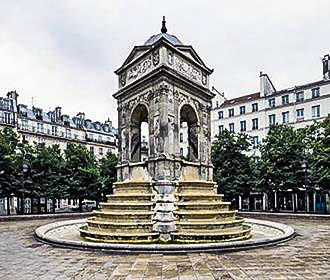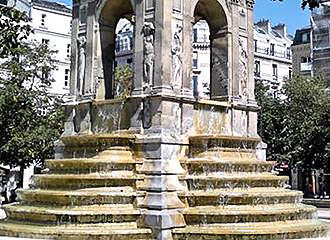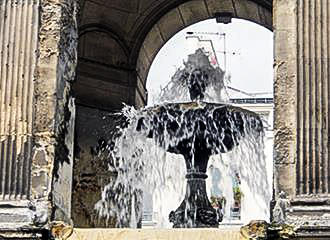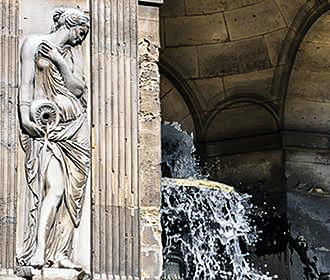Paris Fontaine des Innocents in France
The Paris Fontaine des Innocents in France is the oldest monumental fountain in Paris dating from the 1500s, although originally it was only three sided, but ended up being made into a centrepiece for a square in Paris called the Place Joachim du Bellay.
Time before the Paris Fontaine des Innocents
Originally there was a church and a cemetery called the Saint Innocents located where this Paris square now stands, and over time walls were built to enclosed the cemetery around the 12th century, then later on a fountain was added during the reign of Phillip II of France.
Moving on to the 1500s, different Paris monuments were being commissioned in order to commemorate the entry of King Henry II into the city. And although some of these were temporary, they were to be positioned along his route from the Port Saint-Denis through to the palace on the Ile de la Cite island, that at the time was called the Palais de la Cite.
And although this was the original palace, it was also the seat of parliament, which is now known as La Conciergerie, but the King did not reside there and spent time at the former Palais du Louvre and the Hotel de Tournelles, which is where his mistress lived on the Place des Vosges. But this was destroyed long ago, and is the place where King Henry II died after a jousting tournament went wrong.
Anyway, lets get back to the arrival of King Henry II into Paris..
The original Paris Fontaine des Innocents in France
As we mentioned before, the Paris Fontaine des Innocents in France was commissioned as part of the route that King Henry II would take on his entry to Paris and was to replace an earlier fountain positioned on the wall of the Saint Innocents Cemetery.
This fountain was designed by the French architect Pierre Lescot who worked for many years on the Louvre that at that time was a palace, and the Paris Fontaine des Innocents in France was sculpted by Jean Goujon during the years 1546 through to 1549. In fact, Jean Goujon became the official sculptor of King Henry II and he also worked on a part of The Louvre Palace.
Now the fountain itself originally only had three sides constructed against the side of the cemetery and church walls and was also designed to be a viewing platform for local nobility with the water taps at street level and a stairway up to the top where officials could stand on a balcony and watch the kings procession go by.
After the procession, the Paris Fontaine des Innocents in France still had a trickle of water flowing from it to provide some water for the locals and this continued right up until the 1700s, but by this time, the cemetery had become a mass grave site which eventually led to a vast amount of disease.
So, eventually, in the 1780s, it was decided that the church and cemetery would be demolished and the remains were transported to the Paris Catacombes and the Paris Fontaine des Innocents in France was also going to be demolished.
However, a French writer who also studied architecture, by the name of Antoine Quatremere de Quincy, partitioned to save the fountain from destruction due to it being a masterpiece of Renaissance style sculpture.
The transformed Paris Fontaine des Innocents in France
After this work had been carried out, in place of where the cemetery and church had stood, a stone square was laid out and became part of a vegetable market that had been beside the church, and the fountain that was saved from destruction by the French writer, was re-designed so that it had four sides and would serve as a Paris monument as well as still being a fountain.
It was the prolific French sculptor, Augustin Pajou, who was commissioned to create the fourth side of the Paris Fontaine des Innocents in France, so that it could be erected on a large pedestal within this newly formed Paris square.
Yet, the water supply system in Paris was still not very good, that is, up until Napoleon Bonaparte I had a new aqueduct constructed from the River l’Ourcq and the Canal de l’Ourcq, which then meant that the fountain started being able to have a true flow of water.
But this in itself caused problems, as the amount of water now flowing meant that this monumental Paris fountain was starting to deteriorate and eventually the small bas reliefs had to be removed, and these were then placed within the Musee du Louvre in 1810.
Then by 1858 during the Second French Empire and the amount of work being undertaken by Baron Haussmann to transform the city of Paris, the original market was closed and the square was yet again altered considerably.
At this time, the Paris square was then named the Place Joachim du Bellay and the Paris Fontaine des Innocents in France had to be moved again, so that it would still remain in the centre of the square.
This led to the fountain being positioned on a more modest pedestal of a pyramid style base that would stand in a circular basin, which is how you can still see this historical fountain today.
But bear in mind that if you refer to the square by its official name, many including people residing in the city, do not know the Place Joachim du Bellay, as this Paris tourist attraction is a well known meeting point and is normally referred to as the Square des Innocents after the fountain and the history of the place.
Access to Paris Fontaine des Innocents in France
As we have already mentioned, this monument is located at the Place Joachim du Bellay, which is in the 1st Arrondissement close to Les Halles and Chatelet, which means that both the Les Halles metro stop via line 4 and the Chatelet metro stop via lines 1, 4, 11 and 14 are within easy reach.
There are also many different Paris tourist attractions within walking distance of the Paris Fontaine des Innocents in France such as the Tour Saint Jacques Tower, the Pompidou Centre also known as the Beaubourg and the Place Igor Stravinsky. A little further and you can reach the Hotel de Ville, or the River Seine and cross to the Ile de la Cite where you can find the Conciergerie and other notable Paris monuments.



